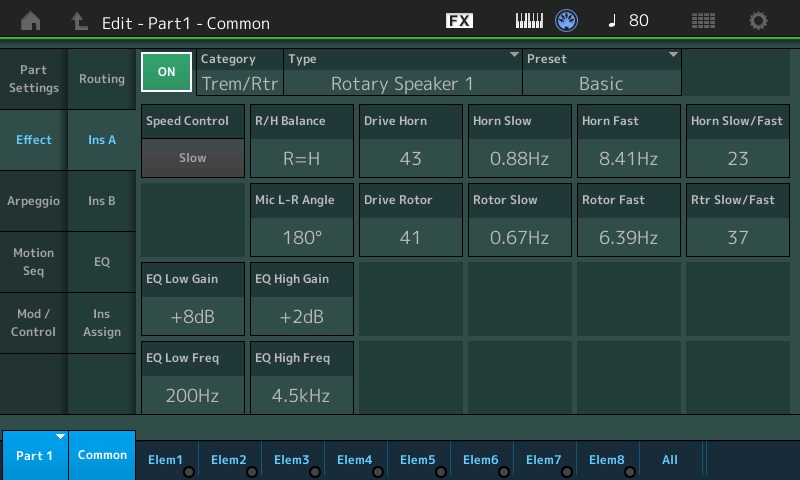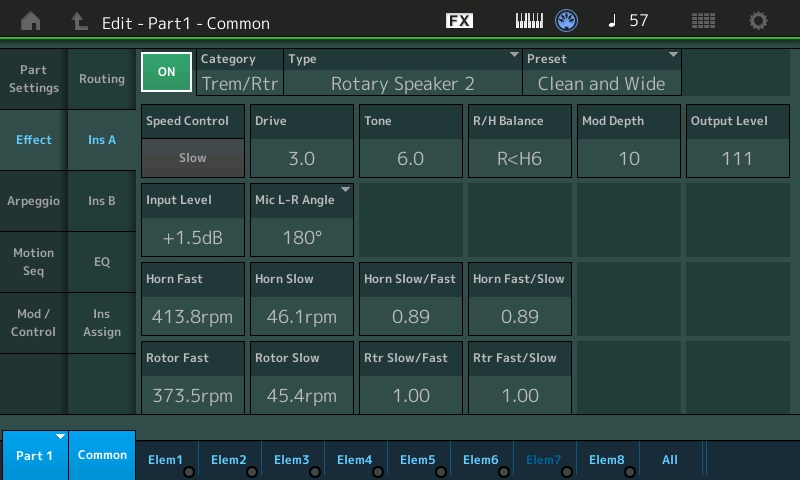It should go without saying — the Leslie rotary speaker sound is critical to getting a good drawbar organ sound.
The Montage/MODX and Genos/PSR product lines have two rotary speaker effects in common:
MODX effect name Genos effect name
---------------- -----------------
Rotary Speaker 1 ROTARY SPEAKER 1
Rotary Speaker 2 REAL ROTARY
Yamaha’s naming scheme often makes it difficult to match up algorithms across product lines. Rest assured, however, the algorithms (and code) are the same. If you need to double check yourself, simply match up the effect parameters as listed in the Data List PDFs.
It’s like the engineers deliberately chose bad, meaningless variable names. Throw preset names on top of the algorithm (effect type) names and things get really confusing!
Rest assured, a lot of the information discussed in this post can be applied to Yamaha synthesizer and arranger products alike.
The real thing: mechanical
Ain’t nothin’ like the real thing, baby. A real Leslie speaker moves air and throws it around in a 3D space. A “2D” stereo simulation will never do. Further, rotary speaker simulators model a mic’ed up speaker putting strong energy surges into the left and right channels.
We all know that a Leslie speaker, like the 122, has a rotating horn and rotor. Yamaha sometimes refer to the rotor as a “woofer”, so keep that in mind when reading through effect parameters!
The horn and rotor each have a motor. The motors have two speeds when turning: slow and fast. A pulley and belt system transfers rotation from a motor to the horn or rotor. The horn motor has three different sized-pulleys: small, middle, and large. The belt is usually around the middle pulley, AKA the factory setting. If the belt is around the small pulley, the rotor turns slower. Put the belt around the large pulley and the rotor turns faster (relative to the factory setting, of course.)
The nominal, factory rotary speeds are:
Slow / "Chorale" in Leslie terminology
Horn 50 RPM 0.83 Hz
Woofer/Rotor 40 RPM 0.67 Hz
Fast / "Tremolo"
Horn 400 RPM 6.67 Hz
Woofer/Rotor 340 RPM 5.67 Hz
You should keep these speeds in mind when tweaking parameters, if you want authenticity. Please note that the rotor turns more slowly than the horn.
I gave the nominal speeds in both rotations per minute (RPM) and cycles per second (Hertz). Some algorithms need RPM and other algorithms need Hertz. Here are conversion formulas:
RPM = Hertz * 60
Hertz = RPM / 60
The pulley and belt system causes even more fun. The belt is flexible and slips around the pulley. Belt tension and wear determine slip. Tension (slip) has a greater effect on acceleration (change from slow to fast) than deacceleration (change from fast to slow). If you want authenticity, acceleration time should be shorter than deacceleration. In other words, the pick-up rate is higher than the slow-down rate.
The real thing: electronics
The Leslie 122 tweeter and woofer are driven by a three tube power amplifier through a cross-over network. The classic Leslie crossover frequency is 800 Hertz. The crossover filter is not super steep and there is definite frequency bleed beyond the crossover frequency.
The power amp consists of a 12AU7A tube driving dual 6550 power tubes. The 12AU7A belongs to a family of nine pin, twin triode tubes. The chief difference between family members is the gain factor. The 12AU7A has a gain factor of 20 while the more powerful 12AX7 — the most familiar member of the family — has a gain factor of 100.
The power amp has a gain knob. At about 70%, the power amp starts to distort. Oh, never, ever go past 70%. Ever. 🙂
The sims
With that background in mind, let’s take a look at the Yamaha MODX rotary speaker effect algorithms.
Historically, “Rotary Speaker 1” came first. The following table summarizes the Genos parameter values for the “Dual Rotary Speaker Bright” and “Dual Rotary Speaker Warm” presets:
# Parameter Bright Warm
-- -------------------- -------- ----------------
1 Woofer Speed Slow 40.2rpm 40.2rpm 0.67Hz
2 Horn Speed Slow 45.6rpm 45.6rpm 0.76Hz
3 Woofer Speed Fast 383.4rpm 363.6rpm 6.06Hz
4 Horn Speed Fast 403.8rpm 403.8rpm 6.73Hz
5 Slow-Fast Time Woofer 39 45
6 Slow-Fast Time Horn 7 7
7 Drive Low 35 31
8 Drive High 37 36
9 Low/High Balance L<H4 L13>H
10
11 EQ Low Frequency 100Hz 100Hz
12 EQ Low Gain +8dB +8dB
13 EQ High Frequency 1.0kHz 1.0kHz
14 EQ High Gain -3dB -4dB
15 Mic L-R Angle 177deg 177deg
16 Speed Control Slow Slow
Feel free to borrow the Genos settings for MODX (and vice versa).
The horn and woofer speeds are ballpark with respect to the factory settings. If there is one major complaint with this algorithm, it’s the relatively weak drive effect. Increasing drive does not add distortion. On MODX, be prepared to couple “Rotary Speaker 1” with an amp simulator (e.g., STEREO SMALL or MULTI FX).
Obviously, there are a lot of parameters to tweak: microphone angle, equalization, rotor and horn balance (low/high balance). Imagine yourself as a studio engineer mic’ing up a real Leslie.
Just for grins, the following table summarizes rotary speaker parameters for four MODX presets:
# Parameter Basic Horn Mic Light Heavy RTR
-- -------------------- -------- -------- -------- ---------
1 Rotor Speed Slow 0.88Hz 0.80Hz 0.88Hz 1.01Hz
2 Horn Speed Slow 1.30Hz 0.72Hz 1.30Hz 0.93Hz
3 Rotor Speed 6.06Hz 6.06Hz 6.06Hz 6.06Hz
4 Horn Speed Fast 7.07Hz 6.73Hz 7.07Hz 6.73Hz
5 Slow-Fast Time Rotor 40 40 40 64
6 Slow-Fast Time Horn 13 12 13 33
7 Drive Rotor 52 37 26 28
8 Drive Horn 31 29 21 22
9 Rotor/Horn Balance RH
10
11 EQ Low Frequency 1.0KHz 1.0KHz 1.0KHz 1.0KHz
12 EQ Low Gain 0.0db -1db 0.0db 0.0db
13 EQ High Frequency 2.0KHz 2.0KHz 1.0KHz 2.0KHz
14 EQ High Gain 0.0db +1db 0.0db 1.0db
15 Mic L-R Angle 150deg 177deg 180deg 30deg
16 Speed Control Slow Slow Slow Slow
Enough starting points yet? Please don’t be afraid to tweak, listen and evaluate. It’s only bits and if you don’t like what you’re hearing, then throw the bits way away. Ever wonder why people spend so much time in the studio? That’s why!
The MODX “Rotary Speaker 2” algorithm is the newer algorithm. It first appeared in Montage and Genos, and it’s been trickling down to mid- and low-range Yamaha products. In Genos-land, it’s known as “REAL ROTARY”. This algorithm provides control over both acceleration and deacceleration times and drive level/tone.
Here are settings from Genos for three drawbar organ voices:
# Parameter Jazz Gospel Rock
-- ------------------- -------- -------- --------
1 Speed Control Slow Fast Fast
2 Drive 2.0 4.0 10.0
3 Tone 8.2 10.0 10.0
4 Low/High Balance L<H10 L<H9 L<H9
5 Output Level 100 100 100
6 Mic L-R Angle 180deg 120deg 120deg
7 Input Level +6dB +6dB +6dB
8 Modulation Intensity 0 63 63
9
10
11 Slow-Fast Time Horn 1.19 1.13 1.13
12 Fast-Slow Time Horn 0.86 0.97 0.97
13 Woofer Speed Slow 43.5rpm 43.5rpm 43.5rpm
14 Horn Speed Slow 47.3rpm 47.3rpm 47.3rpm
15 Woofer Speed Fast 413.8rpm 403.7rpm 413.8rpm
16 Horn Speed Fast 474.4rpm 464.3rpm 464.3rpm
17 Slow-Fast Time Rotor ? ? ?
18 Fast-Slow Time Rotor ? ? ?
Unlike “Rotary Speaker 1”, REAL ROTARY brings overdrive. Turn up the drive to add distortion. Tone sweeps from darker to brighter.
No doubt, you noticed values missing in the last two rows. The Genos user interface supports only 16 effect parameters! [Genos engineers need to fix this limitation.] Your guess is as good as mine — maybe 1.22 and 1.86?
Other blog posts about Yamaha MODX drawbar organ sound design:
- MODX drawbar control
- MODX drawbar waveforms
- Drawbar overdrive
- Drawbar overdrive (slight return)
- Yamaha MODX gospel organ
- Critique: Genos drawbar organ
Copyright © 2023 Paul J. Drongowski


